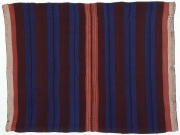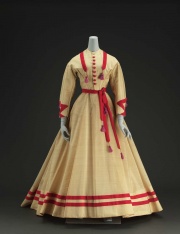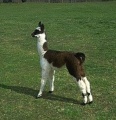Difference between revisions of "Alpaca"
(username removed) |
(username removed) |
||
| Line 2: | Line 2: | ||
== Description == | == Description == | ||
| − | A silky wool obtained from a domesticated llama (''Lama pacos'') found mainly at high altitudes in Bolivia and Peru. Two breeds of alpaca, the huacaya and the suri, were developed in pre-Columbian times. The wool of the suri is fine and silky while the wool of the huacaya is shorter and slightly coarser. The straight, silk-like wool grows about 8 inches annually and will touch the ground if the animal is not sheared. Alpaca wool is lightweight, strong, lustrous, and can be white, light brown, or black. Because it is high in insulation value and resistant to rain and snow, alpaca is used in parkas, sleeping bags, and coat linings. The fibers are used alone or blended with [http://cameo.mfa.org/materials/fullrecord.asp?name=cotton cotton], [http://cameo.mfa.org/materials/fullrecord.asp?name=polyester | + | A silky wool obtained from a domesticated llama (''Lama pacos'') found mainly at high altitudes in Bolivia and Peru. Two breeds of alpaca, the huacaya and the suri, were developed in pre-Columbian times. The wool of the suri is fine and silky while the wool of the huacaya is shorter and slightly coarser. The straight, silk-like wool grows about 8 inches annually and will touch the ground if the animal is not sheared. Alpaca wool is lightweight, strong, lustrous, and can be white, light brown, or black. Because it is high in insulation value and resistant to rain and snow, alpaca is used in parkas, sleeping bags, and coat linings. The fibers are used alone or blended with [http://cameo.mfa.org/materials/fullrecord.asp?name=cotton cotton], [http://cameo.mfa.org/materials/fullrecord.asp?name=polyester%20fiber polyester], or sheep's [http://cameo.mfa.org/materials/fullrecord.asp?name=wool wool] to make dress fabrics and suit fabrics. Imitation alpaca fabric is made of cotton, [http://cameo.mfa.org/materials/fullrecord.asp?name=rayon%20fiber rayon], or [http://cameo.mfa.org/materials/fullrecord.asp?name=acetate%20fiber acetate] yarns interwoven with a mohair filling. |
[[File:52.1653-SC45598.jpg|thumb|]] | [[File:52.1653-SC45598.jpg|thumb|]] | ||
| Line 30: | Line 30: | ||
== Authority == | == Authority == | ||
| − | * ''Encyclopedia Britannica'', http://www.britannica.com Comment: alpaca" from | + | * ''Encyclopedia Britannica'', http://www.britannica.com Comment: alpaca" from Encyclopædia Britannica Premium Service. [Accessed May 8, 2003]. |
| − | * | + | * Hoechst Celanese Corporation, ''Dictionary of Fiber & Textile Technology'' (older version called Man-made Fiber and Textile Dictionary, 1965), Hoechst Celanese Corporation, Charlotte NC, 1990 |
| − | * | + | * J.Gordon Cook, ''Handbook of Textile Fibres:I Natural Fibres'', Merrow Publishing Co. , Durham, England, 1984 |
* Wikipedia, the free encyclopedia, at http://www.wikipedia.com Comment: http://en.wikipedia.org/wiki/Alpaca (Accessed Oct. 18, 2005) | * Wikipedia, the free encyclopedia, at http://www.wikipedia.com Comment: http://en.wikipedia.org/wiki/Alpaca (Accessed Oct. 18, 2005) | ||
| − | * | + | * G.S.Brady, ''Materials Handbook'', McGraw-Hill Book Co., New York, 1971 Comment: p... 32 |
| − | * | + | * Rosalie Rosso King, ''Textile Identification, Conservation, and Preservation'', Noyes Publications, Park Ridge, NJ, 1985 |
| − | * | + | * Marjory L. Joseph, ''Introductory Textile Science'', Holt, Rinehart and Winston, Fort Worth, TX, 1986 |
| − | * | + | * Edward Reich, Carlton J. Siegler, ''Consumer Goods: How to Know and Use Them'', American Book Company, New York City, 1937 |
* ''The American Heritage Dictionary'' or ''Encarta'', via Microsoft Bookshelf 98, Microsoft Corp., 1998 | * ''The American Heritage Dictionary'' or ''Encarta'', via Microsoft Bookshelf 98, Microsoft Corp., 1998 | ||
| − | * | + | * Website address 1 Comment: www.fabrics.net |
[[Category:Materials database]] | [[Category:Materials database]] | ||
Revision as of 06:48, 24 July 2013
Description
A silky wool obtained from a domesticated llama (Lama pacos) found mainly at high altitudes in Bolivia and Peru. Two breeds of alpaca, the huacaya and the suri, were developed in pre-Columbian times. The wool of the suri is fine and silky while the wool of the huacaya is shorter and slightly coarser. The straight, silk-like wool grows about 8 inches annually and will touch the ground if the animal is not sheared. Alpaca wool is lightweight, strong, lustrous, and can be white, light brown, or black. Because it is high in insulation value and resistant to rain and snow, alpaca is used in parkas, sleeping bags, and coat linings. The fibers are used alone or blended with cotton, polyester, or sheep's wool to make dress fabrics and suit fabrics. Imitation alpaca fabric is made of cotton, rayon, or acetate yarns interwoven with a mohair filling.
Synonyms and Related Terms
Lama pacos; Alpaka (Deut., Pol.); alpaca (Esp., It., Ned., Port.); alpaga (Fr.); Luster (Ned); huacaya; suri;
Other Properties
Fiber length = 8 cm (undercoat)
Comparisons
Additional Images
Authority
- Encyclopedia Britannica, http://www.britannica.com Comment: alpaca" from Encyclopædia Britannica Premium Service. [Accessed May 8, 2003].
- Hoechst Celanese Corporation, Dictionary of Fiber & Textile Technology (older version called Man-made Fiber and Textile Dictionary, 1965), Hoechst Celanese Corporation, Charlotte NC, 1990
- J.Gordon Cook, Handbook of Textile Fibres:I Natural Fibres, Merrow Publishing Co. , Durham, England, 1984
- Wikipedia, the free encyclopedia, at http://www.wikipedia.com Comment: http://en.wikipedia.org/wiki/Alpaca (Accessed Oct. 18, 2005)
- G.S.Brady, Materials Handbook, McGraw-Hill Book Co., New York, 1971 Comment: p... 32
- Rosalie Rosso King, Textile Identification, Conservation, and Preservation, Noyes Publications, Park Ridge, NJ, 1985
- Marjory L. Joseph, Introductory Textile Science, Holt, Rinehart and Winston, Fort Worth, TX, 1986
- Edward Reich, Carlton J. Siegler, Consumer Goods: How to Know and Use Them, American Book Company, New York City, 1937
- The American Heritage Dictionary or Encarta, via Microsoft Bookshelf 98, Microsoft Corp., 1998
- Website address 1 Comment: www.fabrics.net




